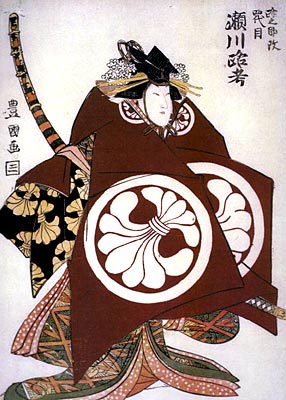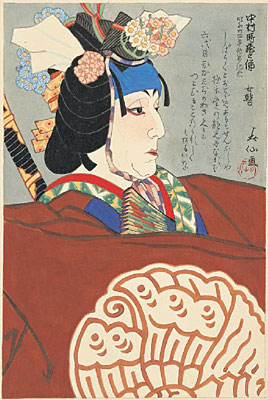| ONNA SHIBARAKU |
| Play title | Onna Shibaraku |
||||||||||||
| History |
The "Onna Shibaraku" scene, parody of the "Shibaraku" scene usually staged during the Edo kaomise programs, with a superheroine instead of a superhero, was staged for the first time in the 11th lunar month of 1746 at the Nakamuraza in the kaomise program "Tenchi Taiheiki", starring the Kamigata actor Arashi Koroku I in the role of the superheroine. The current version of "Onna Shibaraku", perfomed as an independent play instead of a short scene in a kaomise drama, was created in November 1901, at the Ichimuraza, starring Nakamura Shikan V in the role of Tomoe Gozen. |
||||||||||||
| Key words |
Aragoto Haradashi Ôzatsuma Tsurugaoka Hachimangû |
||||||||||||
| Comments |
This is a parody, and it is an extremely amusing play when done well. Though first performed as long ago as 1746, and while retaining the old-world flavour of classical aragoto, "Onna Shibaraku" should nevertheless lose nothing of its contemporary appeal. There is one good reason for this. It's often said that Kabuki as a whole is an actor-centered theatre and that, quite apart from whatever role he is playing, it is the recognition of the actor himself that is paramount in the theatrical experience. In fact, this applies in varying degrees to the vast repertoire of plays and dances, but in no case it this more true than in "Onna Shibaraku", for it is quite literally the leading actor himself who must carry the performance. The story is almost too simple to bother with: an evil lord has plans to usurp control of the country and has arrested a group of nobles who oppose him. He is about to execute them when a young heroine cries, "Shibaraku!", ("Wait!"), after which she enters and saves the day. The story is the same as that of the original "Shibaraku" but features a woman in the leading role instead of a man. The other more important difference however, concerns humour. Once we have accepted the conventions of "aragoto" we can almost believe in the super-human strength of the male hero, Kamakura Gongorô Kagemasa, and even if we do laugh when he decapitates a whole group of enemy men with a single swipe of his sword, we still remain essentially impressed with his brute heroism. But when a female character performs the same action, albeit a "strong woman", it stretches our credulity just that little bit too far. We laugh because this is in no way meant to be serious. We laugh also at the actor's cheek in performing such unbelievable feats, and it is surely this bare-faced cheek that constitutes the main ingredient of parody. Perhaps the most amusing section of the play comes at the very end. It is time for the famous roppô exit performed down the hanamichi after the curtain is drawn, but in most versions of "Onna Shibaraku", Tomoe Gozen professes that, as a woman, she just can't manage it, and asks another famous actor to come and show her how it's done. Tomoe begins by thanking the audience for putting up with her but since the costume is so big and heavy she'd like to change into a normal kimono. There follows a very quick hayagawari costume change after which Tomoe transforms into a geisha, and she is just about to join the audience in the auditorium to watch the rest of the programme when the theatre manager appears to complain that she's forgotten the roppô. After she persuades him to do it for her, they both proceed down the hanamichi on their way to visit another actor's dressing room. Courtesy of Paul M. Griffith |
||||||||||||
| Trivia |
A few cosmetic differences between "Onna Shibaraku" and "Shibaraku" places and heroes:
|
 |
 |
|
Segawa Rokô IV playing the role of Tomoe Gozen in the "Onna Shibaraku" scene of the kaomise drama "Kaikei Yuki no Konoshita", which was staged at the Nakamuraza in the 11th lunar month of 1807 (print made by Utagawa Toyokuni I) |
Nakamura Tokizô III playing the role of Tomoe Gozen in the drama "Onna Shibaraku" (painting made by Natori Shunsen in 1959) |
| The "Onna Shibaraku" scene in the 11th lunar month of 1803 | |
|
|
| Contact | Main | Top | Updates | Actors | Plays | Playwrights | Programs | Links | FAQ | Glossary | Chronology | Illustrations | Prints | Characters | Derivatives | Theaters | Coming soon | News |